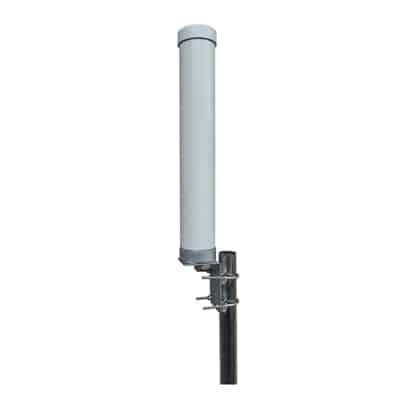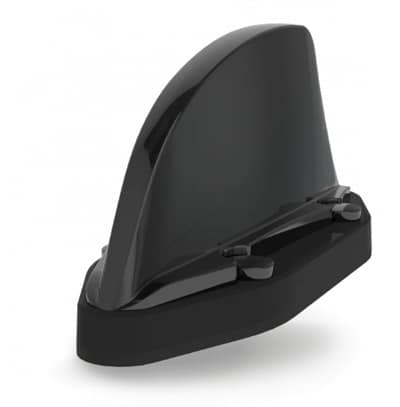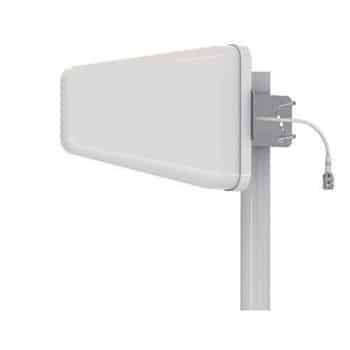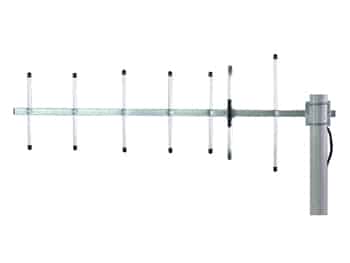
The Paddle Antenna, a unique flat paddle shaped antenna is one of the most commonly used and most versatile components in modern wireless communication systems. Ranging from WiFi networks to 4G/5G cellular systems, UHF communications, and IoT devices, the use of paddle antennas is vast. This article aims to serve as a guide on paddle antennas, starting from its basic definition followed by understanding its working and advancing toward its applications. It also aims to give a general guideline about the basic principle behind paddle antenna working, different types, advantages and selection considerations for paddle antennas in some wireless communication cases.
Table of Contents
ToggleWhat are Paddle Antennas
Paddle antennas are low-profile, flat-panel antennas designed to deliver efficient signal transmission and reception. Unique in their flat, rectangular shape, resembling a paddle or panel, the antenna at its core encases printed circuit board (PCB) element within a durable, often weatherproof housing. Such design allows a perfect blend of functionality, strength, and aesthetics, making it a great choice for indoor and outdoor uses.
One of the defining features of paddle antennas is that they can operate omni-directionally, meaning they can send and receive signals in every direction. Omni-directionality, combined with its compact form factor, has led to its widespread adoption in modern wireless communication systems ranging from consumer-level WiFi routers to sophisticated 5G cellular networks.
How does Paddle Antenna Work
Basic Principles of Operation
The underlying principle of paddle antenna operation is electromagnetic radiation with its internal PCB element acting as a transmitting and receiving component. When an electrical current is applied to the antenna for transmission, it creates an oscillating electromagnetic field. There the field propagates outward from the antenna as radio waves. When receiving signals, the incoming radio waves induce a small electrical current in the antenna, which is amplified and processed by the connected device.
This efficient mechanism is aided by the flat design of paddle antennas, enables effective signal propagation in multiple directions. The donut shape radiation pattern (when viewed from the side) is what gives paddle antennas their omni-directional characteristics, making them highly suitable for a range of communicational needs.
Key Features and Characteristics
- Omni-directionality: Paddle antennas can transmit and receive signals in a wide arc, often covering 360 degrees horizontally and also a significant vertical range.
- Compactness: Their slim profile makes them ideal for applications where space is constrained or where aesthetics are important.
- Efficiency: The PCB-based design allows precise tuning, resulting in high signal efficiency and gain.
- Bandwidth: Many paddle antennas are designed to operate across a range of frequencies, making them ideal for multi-band applications.
- Durability: The enclosed design protects the sensitive PCB element from environmental factors, making it a durable option.
- Polarization: Paddle antennas can be designed for vertical, horizontal, or dual polarization, according to the application requirements.
Types of Paddle Antenna
Portable Paddle Antennas
Portable paddle antennas are primarily used for mobile applications where flexibility and ease of deployment are critical. These antennas are constructed relatively light and often come as foldable or collapsible devices. They are widely used in:
- Field communications for emergency services
- Temporary network setups for events or remote locations
- Portable WiFi hotspots
- Amateur radio operations
4G/5G Paddle Antennas
4G/5G paddle antennas are optimized antennas designed to work within the frequency bands of modern cellular communications keeping antennas on par with the developments in cellular networks. These are equipped with:
- Multi-band support covering a range of 4G and 5G frequencies
- MIMO (Multiple Input Multiple Output) capabilities for enhanced data throughput
- Compact designs suitable for small cell deployments in urban environments
Their applications include:
- Small cell installations for urban capacity enhancement
- Fixed wireless access (FWA) for last-mile connectivity
- In-building cellular solutions to improve indoor coverage
- IoT and M2M (Machine-to-Machine) communications in the smart city initiative
WiFi Paddle Antennas
WiFi paddle antennas are found in both home and office environments. They are designed to operate in the 2.4 GHz and 5 GHz bands used for WiFi communications. Their features include:
- Dual-band support for simultaneous 2.4 GHz and 5 GHz operation
- High gain for extended range in large spaces
- Low visual impact for integration into various environments
WiFi Paddle antennas are mostly used in:
- Residential Wi-Fi routers and mesh network systems
- Enterprise-grade access points for office and commercial spaces
- Public Wi-Fi hotspots in cafes, airports, and other public areas
- Extending Wi-Fi coverage in large buildings or outdoor areas
Omni-Directional Paddle Antennas
While all paddle antennas have a degree of omni-directionality, This type is specifically designed to maximize its omni-directionality. Omni-directional paddle antennas provide broad signal coverage, making them ideal for scenarios where the direction of communicating devices is unknown or changing. Their key features include:
- Near-360-degree horizontal coverage
- Consistent gain across all directions
- Vertical polarization for optimal performance with most mobile devices
They are mostly applied in:
- IoT deployments with dispersed sensor networks
- Public WiFi hotspots in open areas
- Cellular in-building solutions for comprehensive coverage
- Marine communications for boats and ships
Design and Structure of Paddle Antenna
The performance and adaptability of paddle antennas primarily depend on their physical design. The printed circuit board (PCB) located at the heart of the antenna is etched with specific patterns that manipulate antenna’s frequency response, gain, and radiation pattern.
The PCB is enclosed within a protective housing, often made of durable plastics or weather-resistant materials for outdoor models. This housing not only protects the sensitive electronic components but also plays a role in shaping the antenna’s radiation characteristics.
The main structural elements of the antenna can be identified as:
- Radiating Element: The PCB-based core of the antenna, is precisely designed for optimal performance at the targeted frequencies.
- Ground Plane: A conductive surface that works alongside the radiating element to shape the antenna’s radiation pattern.
- Feed Point: Where the antenna connects to the transmitter or receiver, often via a coaxial cable.
- Matching Network: Circuitry designed to optimize the impedance match between the antenna and the connected device, maximizing power transfer.
- Radome: The outer protective cover, which is made of materials transparent to radio waves.
The choice of materials plays a significant role in the antenna performance. Considering the widely used material choices at present
- FR-4, a common PCB material, offers a good balance of cost and performance for many applications.
- PTFE-based materials, while more expensive, can offer superior performance at higher frequencies.
- The choice of radome material can affect signal attenuation and the antenna’s ability to withstand environmental factors.
Frequency and Bandwidth
Paddle antennas are designed to operate across a broad range of frequencies, making them suitable for various applications. However, the specific frequency ranges supported rely on the antenna’s design and use case.
Common frequency ranges include:
- WiFi: 2.4 GHz and 5 GHz bands
- 4G LTE: Various bands between 600 MHz and 2.6 GHz
- 5G: Sub-6 GHz bands and mmWave frequencies (24 GHz and above)
- UHF: 300 MHz to 3 GHz
- IoT: Various bands including 868 MHz, 915 MHz, and 2.4 GHz
Bandwidth considerations are crucial in antenna design and selection as they determine the antenna’s effective operation. Factors affecting bandwidth include:
- Physical Size: Generally, larger antennas can support wider bandwidths.
- Design Complexity: More sophisticated designs can achieve a broader bandwidth.
- Material Properties: The dielectric properties of materials used in construction affect bandwidth.
However, as the bandwidth requirement depends on the application there is often trade-offs between bandwidth, size, and efficiency. For example a wider bandwidth typically comes at the cost of reduced efficiency or increased size , therefore antenna selection should carefully balance these factors based on the specific requirements of the application.
Advantages of Paddle Antennas
Paddle antennas offer several unique advantages that have made them popular across various wireless communication applications:
Compact Size
One of the most sticking advantages is their compact and low-profile design. This makes them ideal candidates for:
- Space-constrained installations, such as on building exteriors or in crowded equipment rooms
- Integration into sleek, modern devices where aesthetics are important
- Portable and mobile applications where minimizing size and weight is crucial
Also, the compactness of paddle antennas makes them more flexible and easier to deploy and integrate into existing infrastructure or products.
High Efficiency
Despite their relatively small size, paddle antennas are known for their high efficiency in signal transmission and reception. This is achieved through:
- Precise PCB design that optimizes the radiating element
- Careful impedance matching to minimize signal loss
- Use of high-quality materials that reduce signal attenuation
As high-efficiency results in better signal quality, extended range, and potentially reduced power consumption, this makes them particularly useful for battery-powered or energy-sensitive applications.
Versatility
Paddle antennas are capable of serving a wide range of applications and environments. Their versatility can be noticed by:
- Being multi-band in support, so one antenna can serve several ranges of frequency
- Serving both indoor and outdoor applications
- Being able to orient in different ways, such as vertically, horizontally, or at an angle
- Being applied with different protocols and standards for communication
This contributes to the need to use multiple specialized antennas, simplifying inventory management and deployment processes for network operators and device manufacturers.
Common Applications of Paddle Antenna
Paddle antennas are applied across a broad spectrum of wireless communication systems:
WiFi Systems
- In routers and access points for home and office networks
- Public WiFi hotspots in cafes, airports, and other public spaces
- Extending WiFi coverage in large buildings or outdoor areas
Cellular Networks (4G, 5G)
- Small cell deployments for urban capacity enhancement
- In-building cellular solutions to improve indoor coverage
- Base station antennas for macro cell networks
- Customer premises equipment (CPE) for fixed wireless access
IoT and Machine-to-Machine (M2M) Communications
- Smart city applications like traffic management and environmental monitoring
- Industrial IoT for factory automation and asset tracking
- Smart home devices and systems
- Agricultural IoT for crop monitoring and precision farming
LoRaWAN and UHF/VHF Systems
- Long-range, low-power IoT networks
- Remote monitoring stations
- Telemetry systems for utilities and infrastructure
- Public safety and emergency communication networks
The wide-ranging applications of paddle antennas demonstrate their adaptability and effectiveness across various wireless communication scenarios.
How to Choose a Paddle Antenna
When selecting a paddle antenna for an application several factors need to be considered:
- Frequency Range: Make sure the antenna supports the frequencies of the application.
- Gain and Radiation Pattern: A high gain can provide a better range but may result in a more directional pattern therefore considering the required coverage area will be more effective.
- Size and Form Factor: Consider the physical space available for antenna installation and also any aesthetic requirements.
- Environmental Considerations: For outdoor applications, choose antennas with appropriate IP ratings for weather resistance.
- Polarization: Match the antenna’s polarization (vertical, horizontal, or dual) to system requirements.
- Connector Type: This should match with the existing equipment (e.g., N-type, SMA, RP-SMA).
- Bandwidth: Consider whether you need single-band, dual-band, or multi-band support.
- Power Handling: Verify that the antenna can handle the transmit power of your system.
- Regulatory Compliance: The antenna should meet the regulatory standards set for the region and application.
To gain a more technical idea consider VSWR (Voltage Standing Wave Ratio) or return loss figures, which indicate how well the antenna is matched to the system’s impedance. Lower VSWR values generally indicate better performance.
Customizing Paddle Antennas
While off-the-shelf paddle antennas match many applications, some applications may require a more custom designed approach. Customizing a paddle antenna can be achieved with the aid of:
- Frequency Tuning: Adjusting the antenna design for precise frequency bands to optimize overall performance
- Radiation Pattern Shaping: Modifying the antenna structure to match required coverage area
- Size and Form Factor Adjustments: Tailoring the physical dimensions to suit precise necessities.
- Integration Features: Adding mounting brackets, connector types, or custom housing designs.
Even though a bit pricey, going for a customized antenna may be beneficial for precise IoT applications, specialized industrial systems, or research settings where available antennas won’t meet all necessities.
Conclusion
Paddle antennas are a versatile solution for a huge variety of wireless communication requirements. Their compact size, high efficiency, and adaptability lead them to be ideal for applications spanning from consumer WiFi to industrial IoT and advanced cellular networks.
As wireless technologies continue to evolve, paddle antennas are likely to remain a crucial component in the communications landscape as their adaptability and efficiency continues to ensure their position in the rapidly changing world of wireless connectivity.







